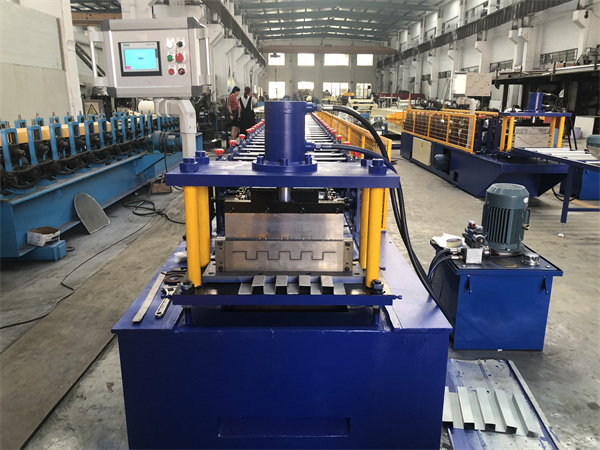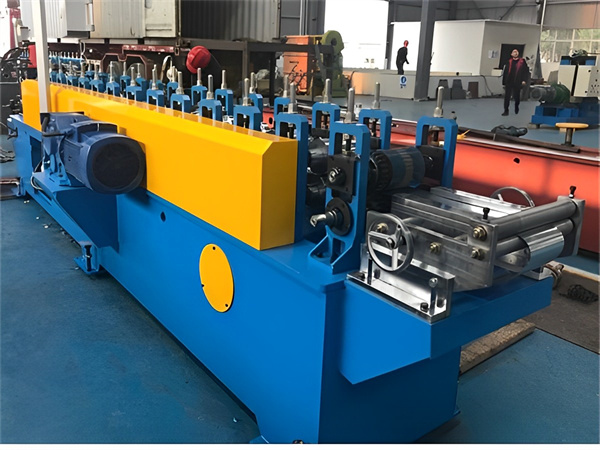1. Introduction
In the realm of modern manufacturing, precision and efficiency are paramount. Industries, such as construction, transportation, and solar energy, require robust and customized metal profiles to meet their specific needs. The track roll forming machine, a powerful piece of equipment, has emerged as a game-changer in the production of high-quality metal profiles.
2. What is a Track Roll Forming Machine?
A track roll forming machine is a specialized manufacturing device that transforms flat metal sheets into continuous and complex metal profiles. The process involves feeding the metal through a series of rollers that gradually shape the desired profile. This efficient and automated method ensures the consistent production of profiles with high dimensional accuracy.
3. How Does a Track Roll Forming Machine Work?
The track roll forming machine follows a systematic approach to convert raw metal sheets into precise profiles. Initially, a coil of metal is loaded onto the uncoiler, and the feeding system guides the material into the roll forming unit. The roll forming unit consists of multiple pairs of rollers, each responsible for a specific incremental change in the profile’s shape. Finally, the cutting system slices the continuous profile into desired lengths, and the control system oversees the entire process.

4. Advantages of Using Track Roll Forming Machines
4.1 Increased Efficiency and Productivity
With automation at its core, track roll forming machines significantly enhance production efficiency. The continuous and seamless process ensures a rapid output of high-quality profiles, reducing labor costs and time consumption.
4.2 Cost-Effectiveness
Track roll forming machines offer a cost-effective solution for profile manufacturing. The minimal scrap generation, coupled with efficient material usage, results in reduced production costs.
4.3 Customization Options
Manufacturers can easily tailor the track roll forming process to produce a wide range of profiles with varying shapes, sizes, and thicknesses, allowing for greater customization to meet specific industry requirements.
5. Applications of Track Roll Forming Machines
The versatility of track roll forming machines finds application in various industries:
5.1 Construction Industry
Track roll forming machines produce profiles used in constructing metal studs, rails, and ceiling suspension systems, revolutionizing the construction process.
5.2 Transportation Industry
In the transportation sector, these machines create metal profiles for the fabrication of vehicle components, such as door tracks and window frames.
5.3 Solar Panel Installation
The solar energy sector benefits from track roll forming machines, which produce customized metal profiles for solar panel mounting systems, ensuring robust and efficient installations.
6. Types of Track Roll Forming Machines
Track roll forming machines come in several configurations to suit diverse manufacturing needs:
6.1 C-Track Roll Forming Machine
The C-track roll forming machine is ideal for producing profiles with a “C” shape, commonly used in construction and other industries.
6.2 U-Track Roll Forming Machine
The U-track roll forming machine specializes in manufacturing profiles with a “U” shape, often employed in transportation applications.
6.3 V-Track Roll Forming Machine
The V-track roll forming machine excels at creating profiles with a “V” shape, widely used in solar panel installation and other industries.

7. Key Components of a Track Roll Forming Machine
To achieve efficient and precise profile manufacturing, a track roll forming machine comprises several essential components:
7.1 Uncoiler
The uncoiler holds the metal coil and feeds the material smoothly into the roll forming unit, ensuring a continuous production flow.
7.2 Feeding System
The feeding system accurately guides the metal sheet through the roll forming unit, maintaining the required alignment and reducing material wastage.
7.3 Roll Forming Unit
The roll forming unit consists of multiple rollers that progressively shape the metal into the desired profile, ensuring dimensional accuracy and repeatability.
7.4 Cutting System
The cutting system precisely cuts the continuous profile into specified lengths, ready for further processing or assembly.
7.5 Control System
The control system oversees the entire manufacturing process, ensuring seamless operation and enabling quick adjustments to various parameters.
8. Factors to Consider When Choosing a Track Roll Forming Machine
Selecting the right track roll forming machine is crucial for successful profile manufacturing. Several factors should be taken into account:
8.1 Material Compatibility
Ensure the machine is compatible with the specific metal material you intend to use, considering factors like thickness, width, and tensile strength.
8.2 Profile Complexity and Size Range
Choose a machine that accommodates the complexity and size range of profiles required for your industry.
8.3 Production Speed
Consider the production speed of the machine to meet your manufacturing volume demands effectively.
8.4 Automation and Control Features
Invest in a machine equipped with advanced automation and control features for enhanced efficiency and precision.
9. Maintenance and Troubleshooting Tips
Proper maintenance and timely troubleshooting are vital for ensuring the longevity and optimal performance of a track roll forming machine:
9.1 Regular Maintenance Routine
Establish a regular maintenance routine, including cleaning, lubrication, and inspection, to prevent breakdowns and extend the machine’s lifespan.
9.2 Common Issues and Solutions
Familiarize yourself with common machine issues and their troubleshooting techniques to minimize downtime and production delays.

10. Safety Precautions for Using Track Roll Forming Machines
As with any industrial equipment, safety is of utmost importance when operating track roll forming machines:
10.1 Proper Training and Certification
Ensure operators undergo comprehensive training and obtain the necessary certifications to handle the machine safely.
10.2 Personal Protective Equipment (PPE)
All personnel working with the track roll forming machine must wear appropriate personal protective equipment, such as safety glasses, gloves, and steel-toed shoes, to prevent injuries from flying debris or accidental contact with moving parts.
10.3 Machine Guarding
Implement effective machine guarding measures to prevent access to hazardous areas during operation. Safety barriers and interlocking mechanisms can minimize the risk of accidents and safeguard workers.
11. Future Trends in Track Roll Forming Technology
As technology continues to evolve, the track roll forming industry is also experiencing advancements that promise even greater efficiency and flexibility:
- Advanced Material Compatibility: Future track roll forming machines are likely to handle an even wider range of materials, including lightweight alloys and composite materials, opening new possibilities for various industries.
- Incorporation of AI and Machine Learning: Integration of artificial intelligence and machine learning algorithms will enhance automation and optimize the machine’s performance, leading to better quality control and reduced material wastage.
- Increased Customization Capabilities: Track roll forming machines will be able to produce highly complex and customized profiles with greater ease, enabling manufacturers to meet the specific demands of diverse applications.

12. Conclusion
The track roll forming machine has revolutionized the way metal profiles are manufactured across multiple industries. With its efficiency, precision, and customization options, this advanced manufacturing device plays a crucial role in enhancing productivity and meeting the unique requirements of construction, transportation, and solar energy sectors, among others.
Incorporating a track roll forming machine into your production process can significantly boost efficiency, reduce costs, and improve the overall quality of your metal profiles. However, it is essential to select the right machine based on material compatibility, profile complexity, production speed, and automation features.
Remember, safety should always be a top priority when operating a track roll forming machine. Adequate training, proper use of personal protective equipment, and strict adherence to machine guarding protocols are imperative to prevent accidents and ensure the well-being of your workforce.
With the continuous advancements in technology, the future of track roll forming machines looks promising. As these machines become more versatile and intelligent, manufacturers can expect even higher levels of productivity and customization.
13. FAQs
1. Can track roll forming machines produce profiles with varying thicknesses?
Yes, track roll forming machines can handle different material thicknesses, making them suitable for a wide range of applications that require profiles of varying strengths.
2. Are track roll forming machines suitable for small-scale manufacturing businesses?
Absolutely! Track roll forming machines come in various sizes and capacities, making them viable for both large-scale industrial production and small-scale manufacturing businesses.
3. How does a track roll forming machine achieve dimensional accuracy in profile manufacturing?
The systematic and gradual shaping process, with precise control over the rollers’ movements, ensures consistent and accurate profile dimensions during manufacturing.
4. Can track roll forming machines handle non-ferrous materials like aluminum and copper?
Yes, track roll forming machines can be adapted to handle non-ferrous materials like aluminum and copper, expanding their applicability in industries beyond steel fabrication.
5. Are track roll forming machines easy to maintain?
With proper maintenance routines and regular inspections, track roll forming machines can be relatively easy to maintain, ensuring their long-term reliability and performance.
